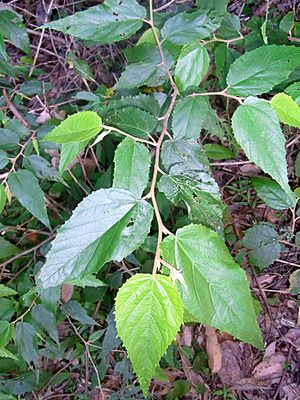Blackfellow's hemp facts for kids
Quick facts for kids Brush kurrajong |
|
|---|---|
 |
|
| Androcalva fraseri, Telegherry River, near Dungog, Australia | |
| Scientific classification | |
| Genus: |
Androcalva
|
| Species: |
fraseri
|
| Synonyms | |
|
|
The Brush kurrajong, also known as blackfellow's hemp, is a common shrub or small tree. Its scientific name is Androcalva fraseri. This plant belongs to the mallow family. You can find it growing in eastern Australia. It often grows up to 8 metres (about 26 feet) tall. It likes to live at the edges of rainforests and in wet eucalyptus forests.
Contents
What Does the Brush Kurrajong Look Like?
The Brush kurrajong is usually a shrub that grows about 2 to 3 metres (6.5 to 10 feet) tall. Sometimes, it can become a small tree, reaching up to 8 metres (26 feet) high. Its leaves grow one after another along the stems. They are shaped like an oval and have bumpy edges. Each leaf is about 5 to 17 centimetres (2 to 7 inches) long and 2 to 7 centimetres (1 to 3 inches) wide. The underside of the leaves looks whitish and feels soft because it's covered in fine hairs.
This plant blooms with small white flowers. They grow in groups or clusters. The best time to see these flowers is from September to November. After the flowers fade, small fruits grow. These fruits are about 1.5 to 2.5 centimetres (0.6 to 1 inch) long.
How Did the Brush Kurrajong Get Its Name?
A French scientist named Jacques Etienne Gay first officially described this plant in 1823. He named it Commersonia fraseri. He wrote about it in a science journal.
Later, in 2011, two scientists, Carolyn Wilkins and Barbara Whitlock, studied the plant's DNA. They found that it was closely related to other plants but needed a new name. So, they changed its scientific name to Androcalva fraseri.
The second part of its scientific name, fraseri, honors Charles Fraser. He was an early botanist who studied plants in New South Wales, Australia. The common names for this plant are brush kurrajong and blackfellow's hemp.
Where Does the Brush Kurrajong Grow?
You can find the Brush kurrajong in rainforests and wet eucalypt forests. It grows along and to the east of the Great Dividing Range in New South Wales and southeastern Queensland, Australia.
In these forests, it often grows near other trees. These include the rough-barked apple, turpentine, and Sydney blue gum. The Brush kurrajong grows quickly. It can easily start growing in places where the ground has been disturbed. This includes areas where some plants have been cleared, like under power lines.
This plant is also a home for a type of leaf beetle called Podagra submetallica. The adult beetles live on it.
Growing Brush Kurrajong in Gardens
People can grow the Brush kurrajong from cuttings. Cuttings are small pieces of the plant that can grow into new plants. It's best to take these cuttings in winter. The plant grows better in gardens if it gets extra water.


